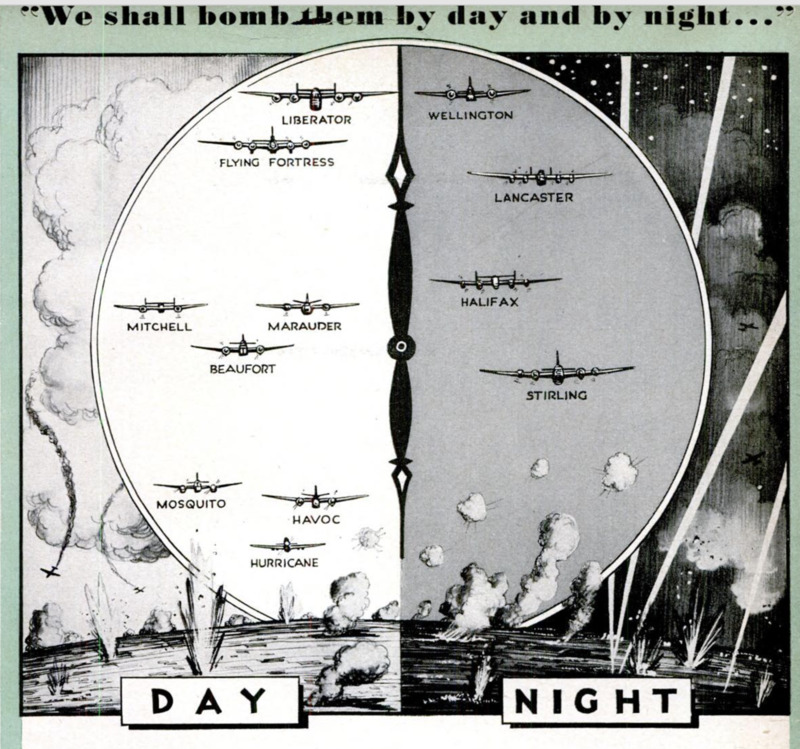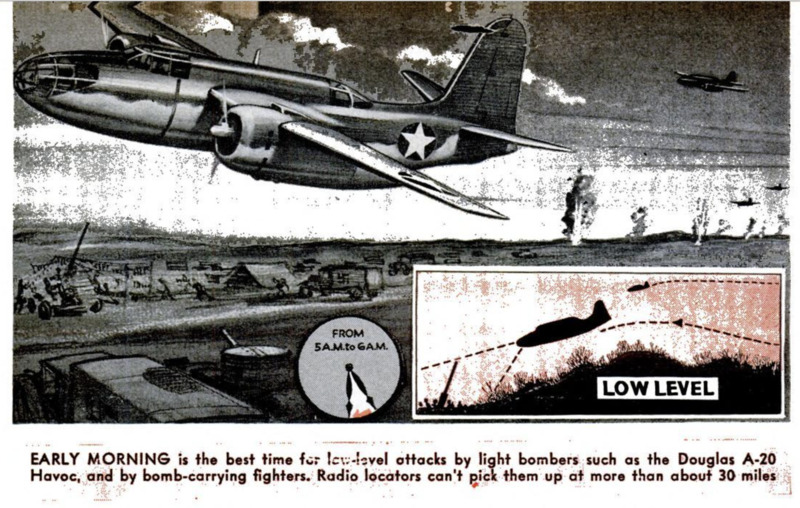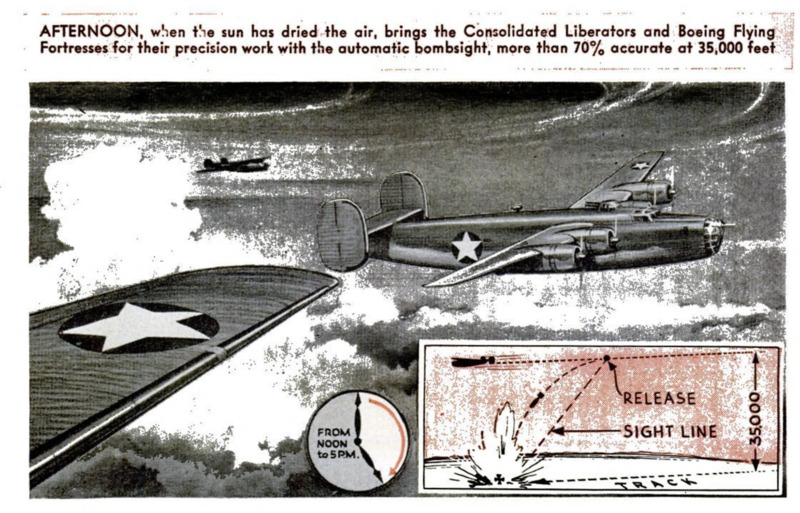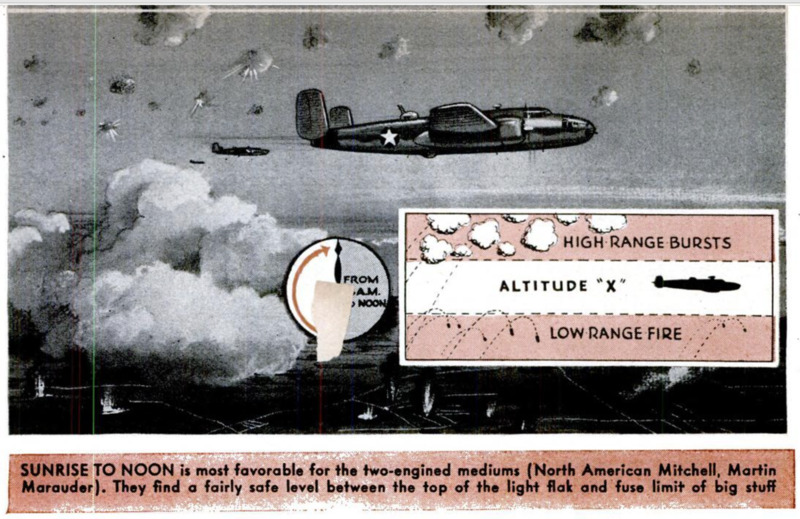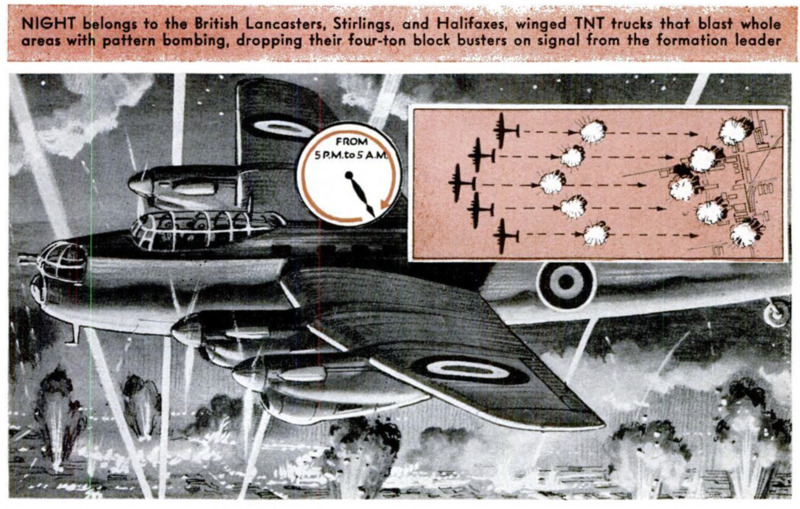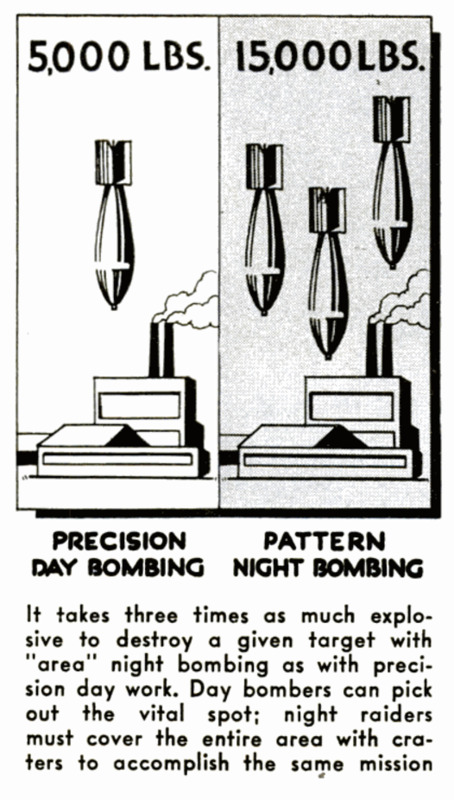-
Title (Dublin Core)
-
Has Precision Bombing Failed?
-
Article Title and/or Image Caption (Dublin Core)
-
Has Precision Bombing Failed?
-
extracted text (Extract Text)
-
THE day after a combined task force of
Boeing Flying Fortresses and Consoli-
dated Liberators put the German sub base
at Vegesack out of action for a season, Gen-
eral Ira Eaker, commander of the Eighth
U.S. Air Force, told American and British
journalists that the experimental phase of
high-altitude bombing had been concluded
and that the business of crippling the Axis
within its own preserves was beginning as
of that day and in full earnest.
The facts that he made public made cer-
tain critics of daylight, high-altitude bomb
ing in both England and the United States
look very foolish. The high-flying Yankees
had been feeling their way along slowly since
last July. The force had been small and
the outside opinion had been that the B-24
and B-17 class had been stymied in the Brit-
ish Isles, venturing out only on an occasion-
al raid under nearly ideal conditions.
‘What the critics of the high-altitude, day-
bombing technique had failed to tell the pub-
lic was that they were comparing the over-
all results of a full fleet of British four-en-
gined, all-altitude night bombers with a
handful of our four-engined machines. Un-
fortunately, neither Britain nor the United
States could have corrected this publicly up
to this point without telling the enemy what
they wanted to know about the disposition
of aircraft.
Now that the score is about to be evened,
facts concerning the relative merits of day
and night bombing can be told.
Those who argue that one or another kind
of bombing should be engaged in exclusively
might well go back to military kindergarten.
The basis for the United Nations system of
bombing the Continent by day as well as by
night is to saturate the enemy's defenses—
keep him on guard without respite at all
posts. Crews that man listening posts on
the French north coast cannot be used to
attack villages in Russia. Pilots who have
to spend nights half awake in dispersal huts
in the defenses of the Ruhr cannot be used
in North Africa.
This projected system of keeping the ene-
my on constant alert requires all kinds of
equipment, as no particular technique of at-
tack will answer for all purposes at all times.
‘There is an axiom among the commanders
who man the flight deck of the unsinkable
carrier which is England. It is that the
day after 150 target areas in Germany and
occupied Europe have been flattened will be
the day of invasion. There are, however, a
lot of things that have to be accomplished
first. Expert estimates put the number of
planes required to complete the job at 6,000
in the four-engined class -2,500 British
heavies in the Halifax-Sticling-Lancaster
class and 3,500 of our Liberators and Flying
Fortresses. The modifying condition is that
these ships shall complete their obliteration
job in 90 days, so that all of these targets
shall be out at the same time.
This prodigious job requires operation
around the clock. Over-all 25% losses suf-
fered by the British in daylight operations
with heavies prove conclusively that flying
these ships within the range of antiaircraft
is an exorbitant expenditure of aircraft. That
leaves the job of daylight bombing to air-
craft capable of operating up out of the flak.
Daytime operation of our four-engined
ships in the high-level
zone stacks up perfectly
with the classic Clausewitz
principle of exposing one’s
strong point to the enemy's
weak one. Our forte is
high-altitude precision
bombing. Our automatic
bombsight has proved it-
self to be 70% accurate—
better than most ordnance
operating under the same
conditions.
Consider the advantage
it has over enemy ground
installations. Once the
ship has attained its serv-
ice ceiling, it is practically
immune to direct antiair-
craft fire from the ground.
Interceptor planes operat-
ing at that altitude have
to struggle to stay on the
wing. For the most part,
the bombers are attack-
ing a fixed target. They
are sure that gravity will
take their missile to the
target level. Their job is
merely to get the bomb onto the target. |
The poor antiaircraft gunner has to shoot
against the pull of gravity at a target that |
is all but invisible, moving at 300 m.p.h.
Any school of gunnery will teach a man
that one blowgun that hits is better than a
16-inch cannon that misses. The precision
bombers can hit what they want about three
quarters of the time. Those who think that |
a near miss by a block buster is as good as |
a direct hit by a bomb a third its size should |
look at the target maps. Most of the things
we need to destroy are heavily defended pin-
points. They have to be laid open by day |
and thoroughly crippled by precision day-
light bombing, then obliterated by area |
bombing at night.
It should also be noted that night offers
no immunity to the raider, either from anti-
aircraft or from defending planes. Airplane
detection is an electronic, not a visual proc-
ess, and detecting devices are mounted on
defending aircraft as well as on the ground.
Darkness merely cuts down the percentage
—and not to any great degree, as indicated
by the recent figures showing that daylight
losses suffered by the Fortresses and Libera-
tors were less per raid and about equal per
ton of explosive carried over target than
losses of the night-operated heavies. [
This is not meant to reflect on the Lan-
casters, Halifaxes, and Stirlings, but merely
to indicate that no one type of bombing is
the whole answer. Winston Churchill sald,
“We shall bomb them by day as well as by
night.” This takes a great
variety of equipment and
application.
While there are many
phases of the problem of
bombardment which may
not be discussed publicly
at this time—formations
both offensive and defen-
sive, and exact methods of
sighting and operation—
nevertheless, the general
purpose and procedure and
the equipment to be used
by the United Nations are
fairly plain. Contrary to
some opinions, the ulti-
mate plan is clear; the
equipment is being ‘mus-
tered and placed on the fiy-
ing line. The operations
now in progress are, in ef-
fect, holding the enemy
open for the inevitable
“Sunday punch.” When
the time comes, it will
mean hitting Hitler at all
hours, in every weather,
from altitudes of 50 feet
to 40,000 feet, day and night and from all
angles. The sleepless defenses, ready to
snap under months of tension, will be only
partly efficient. History will write the rest.
Starting from the ground, the low-level
or zero-altitude bombing pokes rapier-like
fingers at weak spots in the enemy's armor.
AIl kinds of equipment take part in this
type of operation. Douglas A-20's, the swift
near-pursuit-speed Havocs, will sweep over
the Channel at altitudes of 100 feet or less,
carrying delayed-action bombs. Airplane.
detection devices do not work with efficiency
against minimum-altitude bombardment at-
tack.
The low-altitude attack puts the de-
fenders at another clear disadvantage. It
is difficult to depress the antiaircraft guns to
the shallow angle required to fire at this
low, fast-moving target. Larger ordnance is
useless, and the 20- and 40-mm. ground in-
stallations have a singularly bad record
against this type of attack. Life for the
Iow-level bomber crew is not all play, either.
In the first place, navigation and target lo-
cation are incredibly difficult. The terrain,
at 100 feet at 300 m.p.h. is pretty blurred,
and it can get very
unhealthy if one decides to slow down for a
look around at that helght. One has to duck
into nests of hostile defenses, dropping de-
layed-action bombs which, if they exploded
on contact, would destroy the airplane as
well as the target.
‘This light bombing is used against enemy
airfields, small installations, radio-location
stations, minor rail junctions, etc. Its main
value is that the light bomber can blunder
out into weather that would ground the
heavy bombers and thus keep the Conti- |
nent's defenses on alert watch at all times.
Cut-down visibility means litle to these |
ships which, equipped with awninglike flaps
and tricycle landing gear, can slip in and out |
of the dawn Channel fog, making life un.
pleasant for the coastal defenses in France,
the Low Countries, and even West Germany.
Other equipment takes part in this low-
Level attack. ‘The newest entry is the sting.
ing De Havilland Mosquito, a twin-engined
terror built entirely of resin-bonded ply- |
wood, which can divide one ton of payload
between guns and bombs and move in at |
pursuit speed. There are only two German
Bghter planes in existence capable of match.
ing the Mosquito's level speed. Low-level
bombing is Just one of the ship's many tal.
ents. Its general operation procedure in this |
class is to come in on target at tree-top lovel
with its low-speed superchargers In opera- |
yh
blower, climb like a rocket, and get out be-
fore the startled defenses have a chance to
gather their wits. Specially rigged Hur. |
ricanes, Spitfires, Mustangs, and Warhawks,
carrying light bomb loads, sometimes drop |
in for surprise visits,
There is comparatively little day mid-al-
titude bombing over the Continent. This has
proved the most dangerous type because
the equipment is within the best operational
range of the antiaircraft and fighter de- |
fenses. For a reasonable amount of crew
safety, almost as much weight must be in-
vested in defensive armament as would be |
installed in a heavy bomber. These ships
have been found most effective in areas
where the opposition is from fighter craft
rather than from ground installations.
There is, however, a fairly safe operational
altitude for these craft. This is the zone
where the accuracy of the light antiaircraft
weapons has seriously fallen away, yet the
altitude is not high enough for correct fus- |
ing of the heavier explosive shells. From
this altitude the medium bombers have been |
used with good effect against secondary tar-
gets and for diversionary action in support
of the heavy ships by day or by night.
These ships have an operational method
similar to that of the heavy ships. Their
bombing method is a precision run up to the
target under the control of the bombardier,
who uses our regular automatic bombsight.
There are two basic uses in Europe for ships
of this class. The first, as previously stated,
is for direct action against secondary ob-
jectives which do not warrant the attention
of heavy bombardment. The second—and,
in the European theater, the more important
—is the diversionary function—pulling fight-
er power away from important target areas,
thus leaving them open for direct punish-
ment by the heavy bombers.
Our equipment in the medium-bomber
class consists of the Martin B-26 (Maraud-
er) and the North American B-25 (Mitch-
ell). In the medium class the British still
use the Wellington and the Maryland, al-
though in some circles the Bristol Beaufort
is put in the same category.
‘The brunt of the attack, the final blows
that will paralyze the Reich and leave it
stunned and inert, ready for invasion, will |
come from the heavies—the four-engined |
class which night and day will haul weight |
over the Continent to flatten the 150 vital |
areas. The division of the job into day and |
night bombing was dictated by a practical |
application of the men and ships available. |
The general air strategy was to allow the
American equipment and crews to operate
by day in their high-precision raids while
the RAF. performed their pattern or area |
bombing at night. One has only to study |
the history and background of both bom- |
bardment organizations to mark the wis- |
dom of that decision. The B-17 design was |
developed in the old days when an isolation- |
ist-minded nation saw the air problem in |
terms of defending the United States from |
our own shores. The military objective of |
the Flying Fortress class was to create a |
ship that was capable of sinking the indi- |
vidual units of a potential invasion fleet, ship |
by ship, in midocean. The basic assumption |
was taken from the automatic bombsight |
and the amount of explosive projectiles it
would take to sink a capital ship at 70 per- |
cent efficiency. The closely integrated crews |
and their training setup was based on this |
kind of operation—hitting an exact target |
with a four to five-ton explosive load from |
levels above the optimum range of antiair- |
craft, or at altitudes of 28,000 feet and up.
Britain lived closer to the problem. In the
days before the American equipment was
available, the spot precision bombing was
done by medium bombers, but the loss rate
was quite high. Therefore the heaviest
bombing was done at night, The British
theory of night bombing was that if enough
explosive was dropped into a particular area,
by the law of averages part or the whole of
any objective inside it would be demol-
ished. The problem resolved itself to a
simple job of getting the greatest possible
amount of weight over a predetermined area
under the cover of darkness, dumping it,
and high-tailing for home.
Up to this point the joint effort has
worked out quite satisfactorily, for the
equipment has been used for the jobs for
which it was built. Any other application
would be a waste of equipment and effort.
One of the greatest shortcomings of our
Fortresses and Liberators is being remedied
by equipping them for flying and fighting
at night. This will enable them to take ad-
vantage of the cover of darkness for one leg
of a long round-trip bombing flight. They
will time their raids to put them over the
targets at dawn or dusk, when the bomb-
sight can be used, with only half of the trip
exposed to daylight dangers.
What kind of bomber will the near future
bring forth? It is conceded that neither
the American nor the British bomber is
ideal for all-purpose, ‘round-the-clock op-
eration. It would, in operational theory, be
desirable for one design of ship to be able
to operate around the clock and, by ad-
Jjustment within the structure, answer all
purposes. Several experts have offered
opinions as to what this design might look
like, and the consensus is represented by the
drawing on page 45.
‘This may be the ship of the future. How-
ever, the current battle must be fought with
the designs on hand. Fate played Hitler a
nasty trick when the United Nations,
watching for him on a variety of fronts,
developed an equal variety of aircraft types.
If we can, from this day forward, provide
sufficient numbers of aircraft and crews by
accelerating production and training, the
Axis’ days are truly few in number. For the
hour the United Nations airmen can put the
major enemy nerve and production centers
out of action simultaneously, invasion is
just a step across water. This, however,
takes bombing—heavy and unceasing, by
day as well as by night!
-
Contributor (Dublin Core)
-
William S. Friedman (writer)
-
Eric Sloane (illustrator)
-
Language (Dublin Core)
-
eng
-
Date Issued (Dublin Core)
-
1943-07
-
pages (Bibliographic Ontology)
-
41-44, 202, 204, 206
-
Rights (Dublin Core)
-
Public Domain (Google digitized)
-
Archived by (Dublin Core)
-
Matteo Ridolfi
-
Alberto Bordignon (Supervisor)
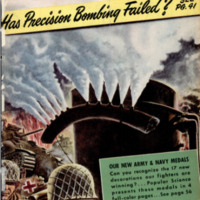 Popular Science Monthly, v. 143, n. 1, 1943
Popular Science Monthly, v. 143, n. 1, 1943

